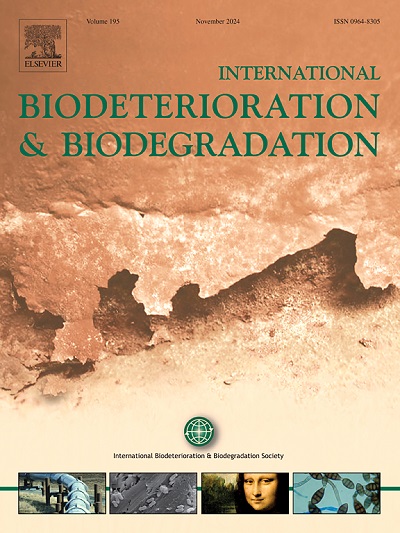金属和pH胁迫调节厌氧膜生物反应器中亚硒酸盐的还原:微生物相互作用的机制见解
IF 4.1
2区 环境科学与生态学
Q2 BIOTECHNOLOGY & APPLIED MICROBIOLOGY
International Biodeterioration & Biodegradation
Pub Date : 2025-06-24
DOI:10.1016/j.ibiod.2025.106155
引用次数: 0
摘要
厌氧膜生物反应器(AnMBR)已成为微生物处理含硒废水的一种很有前途的技术。尽管如此,在共存污染物和进水pH的共同影响下,AnMBR对Se氧阴离子的去除性能和机制仍有待进一步研究。在本研究中,实验室规模的AnMBR用于处理不同进水pH下由竞争电子受体(即SO42−)和共存金属离子(即Cd2+和Ni2+)改性的合成SeO32−废水。在中等pH(5.0 - 7.0)下,可以实现几乎完全的SeO32−去除。得益于功能性微生物群落稳定的代谢活动。相比之下,3.0的低pH值虽然在一定程度上减轻了膜污染,但显著降低了对所有污染物的去除效率。随着pH值从7.0降至3.0,微生物对SeO32−和SO42−氧离子的还原动力学速率降低了一个数量级,表明微生物呼吸对pH值有较强的敏感性。在中等pH下,金属离子的解毒主要是通过沉淀形成金属氢氧化物、硒化物和硫化物,部分通过微生物产物的官能团(包括蛋白质、多糖和腐植酸)的络合作用。根据已知的功能作用,通过宏基因组分析鉴定出7个具有代表性的功能属,包括相对丰度大于1%的硒还原菌(selenium-reducing bacteria, SeRB)和硫酸盐还原菌(sulfate-reducing bacteria, SRB)。主要的和次要的塞族分别促使SeO32−向Se0和Se(−II)还原,而SRB则通过酶转化和涉及生物源S(−II)的非生物反应起作用。在pH为3.0时,SRB几乎无法检测到,而塞尔维亚则持续降低活性,这表明两组之间的酸敏感性不同。研究结果揭示了金属和质子胁迫下AnMBR去除多种氧离子的微生物相互作用机制。本文章由计算机程序翻译,如有差异,请以英文原文为准。

Metal and pH stress regulate selenite reduction in anaerobic membrane bioreactor: Mechanistic insights into microbial interactions
The anaerobic membrane bioreactor (AnMBR) has emerged as a promising technology for the microbial reduction of selenium (Se)-laden wastewaters. Nonetheless, it remains understudied how the removal performance and mechanism of the AnMBR for Se oxyanions respond to the joint impacts of coexisting pollutants and influent pH. In this study, a lab-scale AnMBR was employed to treat synthetic SeO32− wastewater amended with competing electron acceptors (i.e., SO42−) and coexisting metal ions (i.e., Cd2+ and Ni2+) at different influent pH. Nearly complete SeO32− removal could be attained at moderate pH (5.0−7.0), benefiting from the stable metabolic activity of functional microbial communities. In contrast, a low pH of 3.0 markedly decreased removal efficiencies for all contaminants, although it mitigated membrane fouling to a certain extent. The microbial reduction kinetic rates of SeO32− and SO42− oxyanions decreased by one order of magnitude as pH declined from 7.0 to 3.0, indicating the strong pH sensitivity of microbial respiration. At moderate pH, metal ions were detoxified primarily through precipitation as metal hydroxides, selenides and sulfides, and partially via complexation by functional groups of microbial products (including proteins, polysaccharides and humic acid). Seven representative functional genera were identified by metagenomic analysis based on known functional roles, including selenium-reducing bacteria (SeRB) and sulfate-reducing bacteria (SRB) with relative abundances greater than 1 %. The dominant and minor SeRB drove the reduction of SeO32− toward Se0 and Se(−II), respectively, while SRB contributed through enzymatic transformation and abiotic reaction involving biogenic S(−II). At pH 3.0, SRB became nearly undetectable, whereas SeRB persisted with reduced activity, suggesting differential acid sensitivity between the two groups. The findings provided insights into the microbial interaction mechanism of AnMBR for removing multiple oxyanions under metal and proton stress.
求助全文
通过发布文献求助,成功后即可免费获取论文全文。
去求助
来源期刊
CiteScore
9.60
自引率
10.40%
发文量
107
审稿时长
21 days
期刊介绍:
International Biodeterioration and Biodegradation publishes original research papers and reviews on the biological causes of deterioration or degradation.

 求助内容:
求助内容: 应助结果提醒方式:
应助结果提醒方式:


